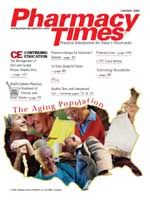Treatment of Patients with Heart Failure in a Hospital Setting
The clinical syndrome termed heart failure (HF) has been well recognized as a leading cause of hospitalization in the United States.1 Patients often are admitted to the hospital due to exacerbations of previously controlled chronic HF (decompensated HF) or newly diagnosed HF (acute HF).
The American College of Cardiology (ACC) and the American Heart Association (AHA) have defined HF as a complex clinical syndrome that can result from any structural or functional cardiac disorder that impairs ventricular emptying (systolic dysfunction) or filling (diastolic dysfunction).2 HF exacerbations are precipitated by acute cardiac events, acute noncardiac events, patient-related factors, or adverse effects of medications.2-4 Table 1 describes the organ system involvement and related physical findings and symptoms found in patients with HF.
The ACC/AHA Task Force has published consensus guidelines for the treatment of chronic HF.2 Management of acute or decompensated HF, although not addressed in these guidelines, has been discussed.5-15 Treatment of decompensated or acute HF consists of determining and treating the underlying cause and establishing the goals of clinical stabilization and improving or alleviating the symptoms. The following discussion will focus on the medications used in the treatment of decompensated and acute HF in hospitalized patients.
Treatment
The treatment of acute or decompensated HF depends on the presentation of the patient. The underlying cause needs to be addressed and corrected, if possible. If the pulmonary capillary wedge pressure (PCWP) is elevated, a diuretic may be the first-line agent of choice, followed by a vasodilator, if necessary. If the cardiac index (CI) is decreased, a positive inotropic agent may be the drug of choice. If the PCWP is elevated and the CI is decreased, a diuretic in addition to a positive inotropic agent may be required. The Figure illustrates assessing patients based on perfusion and congestion status.
Diuretics
Loop diuretics are the most commonly used class of diuretics in the treatment of HF. Although other diuretics have a ceiling effect, the benefit of loop diuretics is based on the fact that an increase in the dose causes an increased effect, regardless of the magnitude of the dose being used. Loop diuretics also may be beneficial in patients who have a creatinine clearance of ??10 mL/min.9 Caution should be used to avoid overdiuresis because the overuse of diuretics may lead to a decrease in renal function.
Vasodilators
Vasodilators work by decreasing resistance in the vasculature, leading to an increase in stroke volume and CI and a decrease in PCWP. These agents differ, based on mechanism of action, adverse effects, level of monitoring required, and cost (Table 2).
Nitroglycerin
Nitroglycerin is an arterial and venous dilator. It has a short half-life and a high incidence of tolerance, which often requires dose escalation to maintain the same response. Headache and hypotension are common side effects experienced by patients and may occur with all formulations of nitrates.
Sodium Nitroprusside
Sodium nitroprusside also is an arterial and venous dilator. It requires invasive hemodynamic monitoring.10 Sodium nitroprusside is metabolized to cyanide and thiocyanate. Therefore, patients must be monitored for toxicity, especially in the setting of renal and hepatic insufficiency and prolonged use.3
Nesiritide
Nesiritide is a recombinant form of the human B-type natriuretic peptide. The effects of nesiritide include decreasing PCWP and systemic arterial blood pressure (BP); increasing natriuresis, diuresis, stroke volume, and CI; and blockade of aldosterone, norepinephrine, and endothelin-1. Contraindications to the use of nesiritide include systolic BP <90 mm Hg, low cardiac filling pressures, and/or cardiogenic shock.12,14
In comparison to dobutamine, nesiritide may be less arrhythmogenic and may produce an increased incidence of nausea and symptomatic hypotension.12-14 In comparison with standard therapy (dobutamine, milrinone, nitroglycerin, and sodium nitroprusside), nesiritide has been shown to have similar improvements in global clinical status, dyspnea, and fatigue.12-14 Nesiritide is significantly more expensive than other vasodilators, based on drug product costs. Studies currently are being conducted, however, concerning its potential to prevent and/or reduce hospitalizations.
Inotropic Agents
Inotropic agents have shown effectiveness in the treatment of patients with severe HF, patients who are refractory to conventional treatment, and those awaiting transplantation11 (Table 3). Positive inotropic therapies upregulate calcium release from the sarcoplasmic reticulum, thereby increasing contractility. The use of intravenous positive inotropic agents is not recommended in the long-term treatment of HF, however, because they may increase mortality.9,11
Conclusion
Acute HF is the cause of many hospital admissions, and therefore it is important that health care professionals understand the optimal treatment of these patients to reduce hospital stay and the readmission rate. These objectives may be met through optimization of "chronic"management of HF. Patients should be educated regarding their diet, medications, and exercise. Specialized HF clinics are ideal for the long-term management of HF patients.
Acknowledgment
The authors wish to acknowledge the priceless contribution of Dr. Jennifer A. Ng to this article.
Dr. Tafreshi is an associate professor of pharmacy and medicine and director of the cardiology pharmacy practice residency at Midwestern University College of Pharmacy-Glendale (MWU-CPG), Glendale, Ariz. Dr. Amabile is an assistant professor of pharmacy practice at MWU-CPG.
For a list of references, send a stamped, self-addressed envelope to: References Department, Attn. A. Stahl, Pharmacy Times, 241 Forsgate Drive, Jamesburg, NJ 08831; or send an e-mail request to: astahl@mwc.com.

